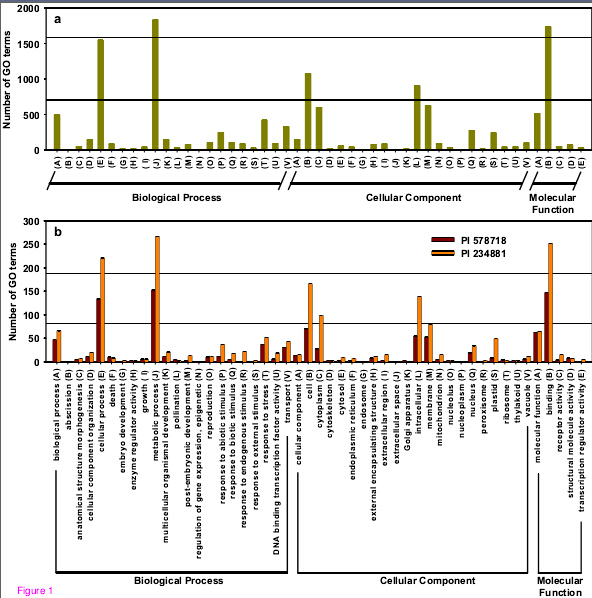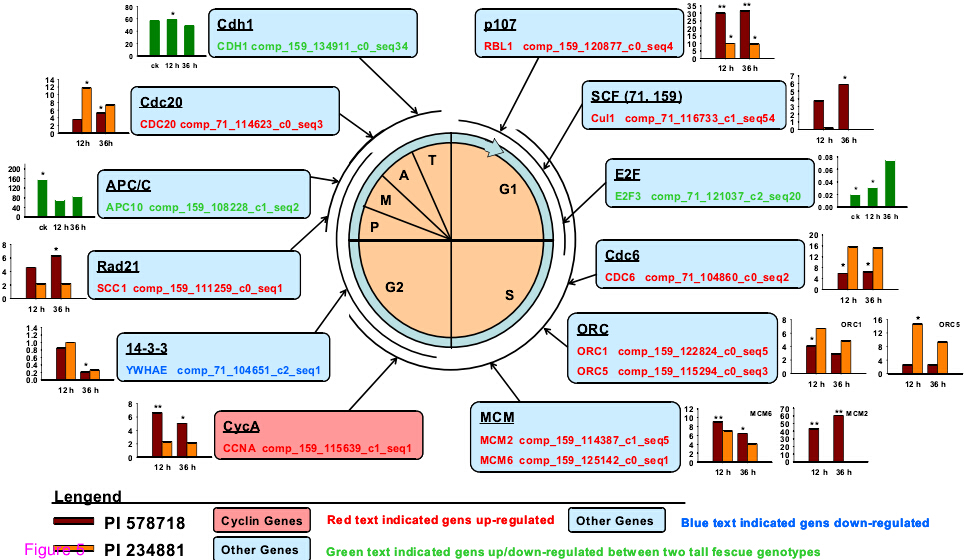Researchers Reveal the New Large-scale Transcriptome Dataset of Cool-season Turfgrass in Response to High-temperature Stress
2014-12-25
Tall fescue (Festuca arundinacea Schreb.), a forage and cool-season turfgrass species, is widely grown in the temperate regions of the world. As one of the limiting factors, high temperature greatly affects forage production and turf management of tall fescue. To date, there is no complete genome sequences of tall fescue, therefore, an accelerated effort should be made to acquire transcriptomes of tall fescue in response to high-temperature stress.
Prof. FU Jinmin and Dr. HU Tao from Wuhan Botanical Garden investigated the responses of two tall fescue genotypes, heat tolerant PI578718 and heat sensitive PI234881, to high temperature at a global transcriptional level using an high- throughput RNA sequencing (RNA-Seq) approach.
A total of 262 million high-quality 100-bp paired-end reads were sequenced and assembled into 31,803 unigenes with average length of 1,840 bp. Based on Gene Ontology (GO) analysis, 12974 unigenes of two tall fescue genotypes, summarized into 49 GO functional subcategories, were identified to have different heat response. The number of functional subcategories and variation degree between PI578718 and PI234881 increased along with increased treatment time.
These unigenes greatly enriched the gene expression library response to high temperature in the grass family, especially in turfgrass and forage grasses. This Transcriptome Shotgun Assembly project has been deposited at DDBJ/EMBL/GenBank under the accession GBYN00000000.
According to the expression data annotated by Kyoto encyclopedia of genes and genomes (KEGG) pathway category “cell cycle” consisted of 101 unigenes in both tall fescue genotypes in response to high temperature stress. Cell cycle and division genes showed the transcript abundance massively increased in the heat-stressed PI578718, suggesting that this genotype had greater self-repair ability, and more activated genes were detected in PI578718.
Plants acquire thermotolerance to respond to high temperature by synthesizing a set of the heat shock proteins (HSPs), including three families: high molecular weight (HMW-HSP), HSP70, low molecular weight (LMW-HSP). In this study, it was found that nine HSP20 genes showed increased transcript abundance in all treatment lines for both PI 578718 and PI234881, and two HSP 90B genes increased abundance in heat-stressed PI 578718. These results suggested that the LMW-HSP and HMW-HSP may play a more important role in enhancing thermotolerance for tall fescue.
This study provided the first large-scale transcriptome dataset in cool-season turfgrass in response to high-temperature stress. High expression levels of genes involved in LMW (HMW)-HSP, antioxidants, cell cycle and cell division and dissimilation (oxidative phosphorylation) in tall fescue respond to heat stress could play a vital role in achieving thermotolerance.
Results were published in BMC Genomics online entitled “An RNA sequencing transcriptome analysis of the high-temperature stressed tall fescue reveals novel insights into plant thermotolerance”. This work was supported by the National Natural Science Foundation of China, the National High Technology Research and Development Program of China.

Functional categorization of assembled unigenes based on Gene Ontology (GO) classification in leaves of two tall fescue genotypes (heat-tolerant PI 578718 and heat-sensitive PI 234881). (Image by HU Tao)

RNA-Seq expression data in heat-stressed tall fescue associated with cell cycle phases. Each box represents a gene product, or group of gene products, and indicates where genes in cell cycle affected by heat stress. (Image by HU Tao)